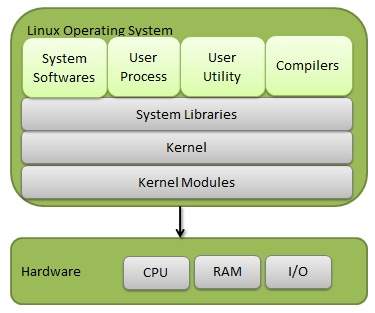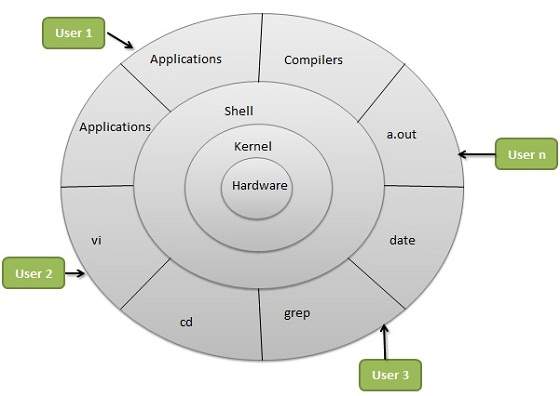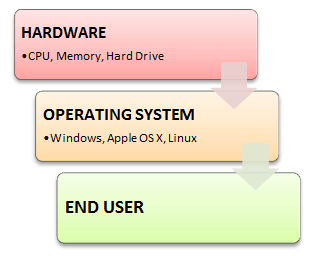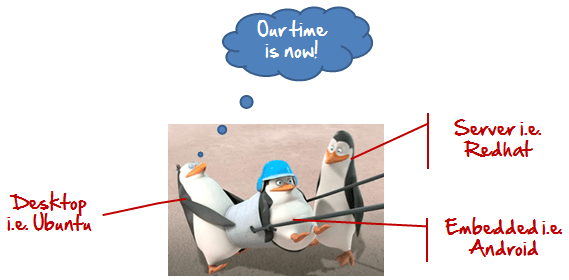Operating System — Linux
Linux is one of popular version of UNIX operating System. It is open source as its source code is freely available. It is free to use. Linux was designed considering UNIX compatibility. Its functionality list is quite similar to that of UNIX.
Components of Linux System
Linux Operating System has primarily three components
- Kernel − Kernel is the core part of Linux. It is responsible for all major activities of this operating system. It consists of various modules and it interacts directly with the underlying hardware. Kernel provides the required abstraction to hide low level hardware details to system or application programs.
- System Library − System libraries are special functions or programs using which application programs or system utilities accesses Kernel’s features. These libraries implement most of the functionalities of the operating system and do not requires kernel module’s code access rights.
- System Utility − System Utility programs are responsible to do specialized, individual level tasks.
Kernel Mode vs User Mode
Kernel component code executes in a special privileged mode called kernel mode with full access to all resources of the computer. This code represents a single process, executes in single address space and do not require any context switch and hence is very efficient and fast. Kernel runs each processes and provides system services to processes, provides protected access to hardware to processes.
Support code which is not required to run in kernel mode is in System Library. User programs and other system programs works in User Mode which has no access to system hardware and kernel code. User programs/ utilities use System libraries to access Kernel functions to get system’s low level tasks.
Basic Features
Following are some of the important features of Linux Operating System.
- Portable − Portability means software can works on different types of hardware in same way. Linux kernel and application programs supports their installation on any kind of hardware platform.
- Open Source − Linux source code is freely available and it is community based development project. Multiple teams work in collaboration to enhance the capability of Linux operating system and it is continuously evolving.
- Multi-User − Linux is a multiuser system means multiple users can access system resources like memory/ ram/ application programs at same time.
- Multiprogramming − Linux is a multiprogramming system means multiple applications can run at same time.
- Hierarchical File System − Linux provides a standard file structure in which system files/ user files are arranged.
- Shell − Linux provides a special interpreter program which can be used to execute commands of the operating system. It can be used to do various types of operations, call application programs. etc.
- Security − Linux provides user security using authentication features like password protection/ controlled access to specific files/ encryption of data.
Architecture
The following illustration shows the architecture of a Linux system −
The architecture of a Linux System consists of the following layers −
- Hardware layer − Hardware consists of all peripheral devices (RAM/ HDD/ CPU etc).
- Kernel − It is the core component of Operating System, interacts directly with hardware, provides low level services to upper layer components.
- Shell − An interface to kernel, hiding complexity of kernel’s functions from users. The shell takes commands from the user and executes kernel’s functions.
- Utilities − Utility programs that provide the user most of the functionalities of an operating systems.
What is Linux Operating System? Introduction to Linux OS
LINUX is an operating system or a kernel distributed under an open-source license. Its functionality list is quite like UNIX. The kernel is a program at the heart of the Linux operating system that takes care of fundamental stuff, like letting hardware communicate with software.
Why do you need an OS?
Every time you switch on your computer, you see a screen where you can perform different activities like write, browse the internet or watch a video. What is it that makes the computer hardware work like that? How does the processor on your computer know that you are asking it to run a mp3 file?
Well, it is the operating system or the kernel which does this work. So, to work on your computer, you need an Operating System (OS). In fact, you are using one as you read this on your computer. Now, you may have used popular OS’s like Windows, Apple OS X, but here we will learn introduction to Linux operating system, Linux overview and what benefits it offers over other OS choices.
Who created Linux?
Linux is an operating system or a kernel which germinated as an idea in the mind of young and bright Linus Torvalds when he was a computer science student. He used to work on the UNIX OS (proprietary software) and thought that it needed improvements.
However, when his suggestions were rejected by the designers of UNIX, he thought of launching an OS which will be receptive to changes, modifications suggested by its users.

Click here if the video is not accessible
History of Linux
So Linus devised a Kernel named Linux in 1991. Though he would need programs like File Manager, Document Editors, Audio -Video programs to run on it. Something as you have a cone but no ice-cream on top.
As time passed by, he collaborated with other programmers in places like MIT and applications for Linux started to appear. So around 1991, a working Linux operating system with some applications was officially launched, and this was the start of one of the most loved and open-source OS options available today.
The earlier versions of Linux OS were not so user-friendly as they were in use by computer programmers and Linus Torvalds never had it in mind to commercialize his product.
This definitely curbed the Linux’s popularity as other commercially oriented Operating System Windows got famous. Nonetheless, the open-source aspect of the Linux operating system made it more robust.
Linux gets its due attention
The main advantage of Linux was that programmers were able to use the Linux Kernel to design their own custom operating systems. With time, a new range of user-friendly OS’s stormed the computer world. Now, Linux is one of the most popular and widely used Kernel, and it is the backbone of popular operating systems like Debian, Knoppix, Ubuntu, and Fedora. Nevertheless, the list does not end here as there are thousands of Best versions of Linux OS based on the Linux Kernel available which offer a variety of functions to the users.
Linux Kernel is normally used in combination of GNU project by Dr. Richard Stallman. All mordern distributions of Linux are actually distributions of Linux/GNU
Benefits of Linux
Linux OS now enjoys popularity at its prime, and it’s famous among programmers as well as regular computer users around the world. Its main benefits are –
It offers a free operating system. You do not have to shell hundreds of dollars to get the OS like Windows!
- Being open-source, anyone with programming knowledge can modify it.
- It is easy to learn Linux for beginners
- The Linux operating systems now offer millions of programs/applications and Linux softwares to choose from, most of them are free!
- Once you have Linux installed you no longer need an antivirus! Linux is a highly secure system. More so, there is a global development community constantly looking at ways to enhance its security. With each upgrade, the OS becomes more secure and robust
- Linux freeware is the OS of choice for Server environments due to its stability and reliability (Mega-companies like Amazon, Facebook, and Google use Linux for their Servers). A Linux based server could run non-stop without a reboot for years on end.
Is it for me?
Users, who are new to Linux, usually shun it by falsely considering it as a difficult and technical OS to operate but, to state the truth, in the last few years Linux operating systems have become a lot more user-friendly than their counterparts like Windows, so trying them is the best way to know whether Linux suits you or not.
There are thousands of Best Linux OSs and Linux softwares available based on the Linux Kernel; most of them offer state-of-the-art security and applications, all of it for free!
This is what Linux is all about, and now we will move on to how to install Linux and which Distribution you should choose.
Then Why Linux?
UNIX is called the mother of operating systems which laid out the foundation to Linux. Unix is designed mainly for mainframes and is in enterprises and universities. While Linux is fast becoming a household name for computer users, developers, and server environment. You may have to pay for a Unix kernel while in Linux it is free.
But, the commands used on both the operating systems are usually the same. There is not much difference between UNIX and Linux. Though they might seem different, at the core, they are essentially the same. Since Linux is a clone of UNIX. So learning one is same as learning another.






